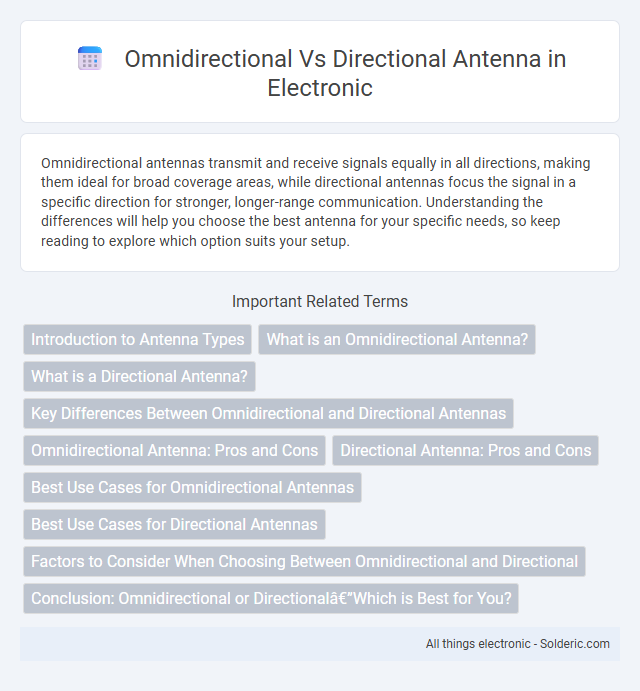Omnidirectional antennas transmit and receive signals equally in all directions, making them ideal for broad coverage areas, while directional antennas focus the signal in a specific direction for stronger, longer-range communication. Understanding the differences will help you choose the best antenna for your specific needs, so keep reading to explore which option suits your setup.
Comparison Table
| Feature | Omnidirectional Antenna | Directional Antenna |
|---|---|---|
| Radiation Pattern | 360deg horizontal coverage | Focused beam, limited angle |
| Range | Short to medium distance | Long distance, higher gain |
| Use Cases | Wi-Fi routers, mobile devices | Point-to-point links, radar |
| Signal Gain | Low to moderate gain (2-9 dBi) | High gain (10-24 dBi+) |
| Installation | Simple, no precise alignment needed | Requires precise aiming |
| Interference | Higher susceptibility | Reduced interference |
| Cost | Generally lower | Usually higher |
Introduction to Antenna Types
Omnidirectional antennas radiate signals uniformly in all horizontal directions, making them ideal for broad coverage in wireless networks and mobile communications. Directional antennas concentrate signal power in a specific direction, enhancing range and signal quality for point-to-point links or targeted coverage areas. Choosing the right antenna type affects your network's efficiency by balancing coverage area and signal strength.
What is an Omnidirectional Antenna?
An omnidirectional antenna radiates radio waves uniformly in all horizontal directions, providing 360-degree coverage ideal for broad area communication. Your wireless devices benefit from this antenna type when signals need to be distributed evenly around a central point, such as in Wi-Fi routers or mobile networks. Unlike directional antennas, omnidirectional models optimize connectivity in environments where users move or are dispersed widely.
What is a Directional Antenna?
A directional antenna is designed to focus radio wave transmission and reception in a specific direction, enhancing signal strength and range compared to omnidirectional antennas. By concentrating energy toward a particular area, it reduces interference and increases performance for long-distance communication. You can optimize your wireless network or communication system by selecting a directional antenna for targeted coverage and improved signal quality.
Key Differences Between Omnidirectional and Directional Antennas
Omnidirectional antennas transmit and receive signals uniformly in all directions, making them ideal for broad coverage in environments where the signal needs to reach multiple devices spread out in various locations. Directional antennas concentrate the signal in a specific direction, providing higher gain and longer range, which is beneficial for point-to-point communication or targeted wireless connections. Choosing between these types depends on your network layout and whether you prioritize wide coverage or focused, high-strength signal transmission.
Omnidirectional Antenna: Pros and Cons
Omnidirectional antennas provide 360-degree signal coverage, making them ideal for environments where consistent connectivity is needed in all directions, such as in Wi-Fi routers or mobile communication towers. Your network benefits from their ability to maintain broad area coverage, but signal strength and data transmission range may be lower compared to directional antennas due to signal dispersion. These antennas excel in scenarios requiring multi-device connectivity but may suffer from increased interference and reduced efficiency in long-distance communication.
Directional Antenna: Pros and Cons
Directional antennas offer focused signal transmission and reception, resulting in higher gain and improved range in a specific direction, making them ideal for point-to-point communication. Their ability to reduce interference from unwanted sources enhances signal quality but limits coverage area, requiring precise alignment for optimal performance. These antennas are less effective for broad coverage, as their narrow beamwidth confines connectivity to targeted zones.
Best Use Cases for Omnidirectional Antennas
Omnidirectional antennas excel in environments requiring 360-degree signal coverage, making them ideal for Wi-Fi routers in homes or office spaces where users move freely. Their ability to broadcast uniformly in all directions ensures consistent connectivity for multiple devices simultaneously, enhancing overall network performance. You benefit from improved reception in open or cluttered spaces where signals need to reach devices located at varying angles and distances.
Best Use Cases for Directional Antennas
Directional antennas excel in applications requiring focused signal transmission over long distances, such as point-to-point communication links and wireless backhaul networks. These antennas concentrate energy in a specific direction, improving signal strength and reducing interference in environments like rural areas, large campuses, and outdoor events. Their precise targeting makes them ideal for connecting remote locations or boosting signals in high-traffic zones where network performance and reliability are critical.
Factors to Consider When Choosing Between Omnidirectional and Directional
Factors to consider when choosing between omnidirectional and directional antennas include coverage area, signal strength, and application environment. Omnidirectional antennas provide 360-degree coverage suitable for broad, multi-directional signal distribution, while directional antennas focus energy in a specific direction, offering higher gain and reduced interference. Understanding factors such as distance requirements, potential obstacles, and interference levels is critical for optimizing network performance and antenna placement.
Conclusion: Omnidirectional or Directional—Which is Best for You?
Choosing between an omnidirectional and directional antenna depends on your specific signal coverage needs and environment. Omnidirectional antennas deliver 360-degree signal coverage, ideal for broad area reception in urban or mobile settings, while directional antennas focus signal strength in a targeted direction, maximizing range and performance for point-to-point communication or in areas with signal interference. Evaluate factors like coverage area, distance, and obstacles to determine the optimal antenna type for enhanced connectivity and signal reliability.
omnidirectional vs directional antenna Infographic

 solderic.com
solderic.com